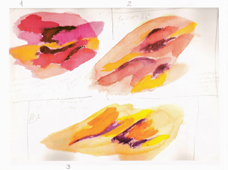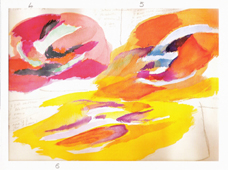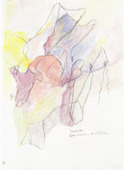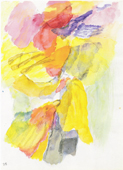SOME STUDIES FROM "THE BOOK OF METHOD"
- Original developments on a theme of colour (*)
From Book 38, pp. 33-34.
The study is made up of 6 different exercises with the following annotations in the Master’s handwriting:
 |
| Image 005 - B. Assenza * |
PRINCIPLES OF GOETHE’S PAINTING
1.
I red (calm space)
II black violet / character
III reprise in red / character
IV violet or IV yellow
V yellow in relation to violet V violet
2. for course
I orange calm space 2A
II black violet / character 2B
III reprise of orange / character
IV indigo
V yellow
3.
III A
2nd course B
and individual students
 |
|
Image 006 - B. Assenza * |
4. as for 3 + white
I carmine (for white)
II deep indigo / character
III cobalt blue
IV cadmium orange
V green
5. as with 3 + white
I chrome orange (for white)
II deep Windsor violet / character
III bright red (union of orange and violet)
IV yellow
V blue (Klang) (= resonance – trans.) and with 2 plus white and blue
6. as with 3 + white
I yellow for white
II violet purple / character
III orange
IV violet
The various exercises above reflect some initial passages from the study of “The Experience of Colour”. The numbers refer to the sequence of the various operations.
Some colours are called on as they are intervals between basic ones, others come in as “characterizing” functions of the experience, and others still have the role of counterbalancing the greater weight given by the characterizations and are offered as unformed compensatory surfaces (“spaces”).
- Study of the lines of composition (**)
From book 20, p.43 “The line”
 |
|
Study for lines of a composition - B. Assenza ** |
Research for lines, which running along the movement of colours tie them together or separate them to construct a bearing compositional structure.
In this study, Assenza notes: “First of all a single-melodic line”. It must have a direction and move with a harmonious and consequential movement in every segment being carried out.
There follow other lines connected with the first, which also take part in completing the bearing structure or suggest forms that could be developed as figures. For example in this study the suggestions to the heads that overlook two forms to the right.
One should also observe the structural lines in the watercolour (Untitled) reproduced on the previous pages. Here the lines come to form an integral part of the painting. As they flow in towards the centre they offer access to the formation of a figure.
-Line = surface. Composition in white (**)
From book 25, p. 54
 |
|
Lines, Surface, Composition- B. Assenza ** |
Assenza notes: “(1) Line as movement in relation to a determinate colour evoked interiorly. (2) Line as a boundary to a space.” Steiner points out that lines doe not exist in nature, but only multiform surfaces of colour. What conventionally appear to us as a line is only a boundary between different colour forms and surfaces.
For this study, the vertical sign at the centre (“movement in relation to a determinate colour”) does not act as a line. It is instead a narrow and long colour surface and insofar as it is a tonality and movement it arises as the interval required by the pre-existing tonalities, which stand alongside them, and with which it simultaneously acts as a characterization.
An analogous function is carried out by other sections or small surfaces with a curved progression.
When the line adopts the function of a boundary between different colour surfaces, it is no longer a line, but extends to create, itself, a surface or “space”.
- Composition. (Orange = Yellow + Red) (**)
From Book 21, p. 32.
 |
| Composition (orange=yellow+red) - B. Assenza ** |
The study is in a very late stage of development but is still incomplete. The initial theme is the colour orange, which immediately hails back to its yellow and red components and then to the corresponding complements of blue, violet and green (intervals).
The composition shows the colours of the theme (orange + yellow and red) in eminent and balanced positions on the upper and lower sides, however with a clear sign back to the centre of the picture.
The cold colours (green, blue) instead appear mainly as carrying “spaces” and do not stress significant gestures and so do not consolidate into forms. They counterbalance the warm tones.
The study also contains some lines (gestures), which describe the more significant movements, while others suggest forms that in turn release figurative elements.
|




